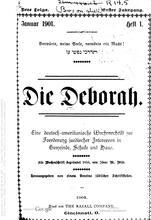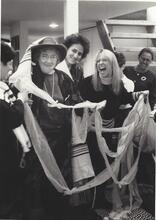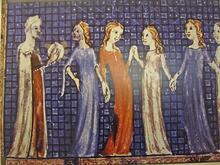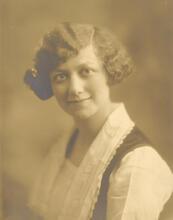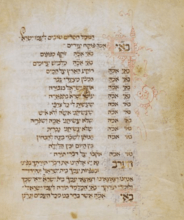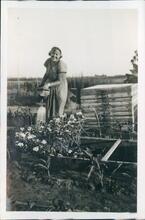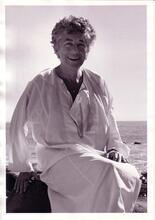Poland: Early Modern (1500-1795)
Jewish women in Poland were integral to the cultural framework of society but were often segregated from men in religious practices such as study and prayer. Strict gender roles dictated women should be modest, clever, pious, of scholarly pedigree, and submissive to their husbands. At times these boundaries were crossed; as the world grew slightly more progressive, women were allowed to read more scripture and study with their husbands. In addition, women were sometimes expected to work outside the home to subsidize the husband’s income. As women were allowed to participate more fully in religious rituals, they gained their own permanent space in synagogue where they could pray separately, but as fully, as men.
Sources on Jewish Women in Poland
Scholars long maintained that the dearth of source material containing information on women prevented incorporating them into the historical narrative about the Jews in Poland (or, as it was officially called in this period, The Polish-Lithuanian Commonwealth, as a result of the federation in 1569 between Poland—including most of today’s Ukraine—and what was then Lithuania—including also today’s Belarus, Latvia, and part of Estonia). We now know that this is not correct. There are several main classes of sources which are rich in material pertaining to women. The first is Yiddish books, whose readers were largely female and which illustrate what Jewish women read and the societal expectations of them that the authors (mostly male members of the rabbinic elite) represented. These books include translations and re-workings of the Bible based on rabbinic interpretation (e.g. Shmuel Bukh [Augsburg 1544], Ze’enah u-Re’enah, [Lublin ca. 1600]); manuals that instructed women in the observance of the commandments (A biblical or rabbinic commandment; also, a good deed.mitzvot) especially incumbent upon them (e.g. Azharat Noshim [Cracow 1535], Seder Noshim [Cracow 1541], Seder Mitzvos Noshim [Cracow 1577]; morality anthologies and behavior manuals, like the Brantspiegel [Cracow 1596] and Menekes Rivka [Prague 1609] written by a woman, Rebekah Tiktiner), incorporating admonitions illustrated by didactic anecdotes; pious story anthologies like the Mayseh Bukh (Basel 1602); and the Tkhines petitionary prayer collections, dating from the late sixteenth century. Some tkhine authors were women (e.g. Leah Dreyzl bas Moses, Serl bas Jacob Kranz, Shifrah bas Joseph, Sarah Rebecca Rachel Leah Horowitz, Sarah bas Tovim; the historicity of some female authors requires further clarification) and their work offers us access to a genuine feminine historical voice.
Next are archival sources, both Polish and Jewish. Various types of official Polish lists of town residents, property owners, petitioners, taxpayers, people fined in court, and borrowers or lenders often contain names of women who acted in these capacities as well as other bits of information about them, such as marital status, occupation, and financial situation. Of particular interest is the 1764–1765 census of Polish Jewry which undercounted the Jewish population (since the census was for purposes of taxation, Jews tended to evade enumeration) but is nevertheless a valuable source for studying the Jewish family and household. In this material women are prominent not only as wives, mothers, and daughters, but as servants and widowed heads of households as well. Other Polish sources likely to contain information about women are law court protocols, correspondence between nobles, petitions submitted by Jews to Polish authorities, loan records, tax records, and property inventories. An important type of Jewish source where women appear frequently as the subject of legislation or as actors in the public sphere are communal minute books (pinkasim; singular: pinkas) which, written primarily in Hebrew, typically record the legislative enactments, real estate transactions, election results, budget, and other business of each community.
The third type of source that can relate to women consists of traditional rabbinic literature and classic literary historical sources, such as the Memoirs of Ber of Bolechow (written by Dov Ber Birkenthal, 1723–1805) and the Autobiography of Solomon Maimon (c. 1753–1800). By concentrating on the background of these works, rather than the foreground that was intended to be the focus of attention, readers can often learn details about women’s dress, occupations, courtship and marriage customs, child-rearing practices, status in the family and the community, housekeeping matters, education, religious practice, etc.
Gender Roles in Polish-Jewish Society
In theory, Polish-Jewish society was highly gendered, with each gender occupying its particular social and cultural sphere. For example, shortly before 1570 Rabbi Moses Isserles (1530–1572), rabbi of Cracow, wrote in his glosses on the Shulhan Arukh (code of Jewish law, Section: Orah Hayyim, chapter 17, paragraph 2) that
In any case, if [women] want to wear [a Four-cornered prayer shawl with fringes (zizit) at each corner.tallit] and make the blessing over it, they may as with all other time-conditioned positive commandments; however, it appears to be arrogance [yoharah; see Lit. "additions." Collections of comments made by Rashi's students and descendants who undertook to expand, elaborate and develop Rashi's commentary on the Talmud.Tosafot, Rosh (Asher ben Jehiel, 1250–1327) on chapter two of BT The Jewish New Year, held on the first and second days of the Hebrew month of Tishrei. Referred to alternatively as the "Day of Judgement" and the "Day of Blowing" (of the shofar).Rosh Ha-Shanah and RaN (Nissim ben Reuben Gerondi, ?1310–?1375) chapter one of BT Kiddushin], and therefore they should not wear zizit. …
This passage, where Rabbi Isserles noted that wearing of zizit by women was permissible by technical The legal corpus of Jewish laws and observances as prescribed in the Torah and interpreted by rabbinic authorities, beginning with those of the Mishnah and Talmud.halakhic standards, underscores the importance of gender categories in his society. Despite technical permissibility, he ruled, echoing earlier authorities, that women should not wear zizit because it betrayed arrogance (yoharah) on their part. The implication is that women donning zizit were aspiring to male status and in doing so threatening to violate the gender boundary.
One important way in which the stark existence of this boundary was confirmed was in the common beliefs about women which expressed gender expectations, socio-cultural hierarchy, and the desire to limit women to strictly defined behaviors. According to various texts the ideal woman was modest, clever, beautiful, retiring, charming, energetic, pious, charitable, of scholarly pedigree, chaste, and obedient to her husband—some authorities even considered wives to be tantamount to slaves and made allowances for husbands to strike them as a “disciplinary” or “educational” measure. Women were considered to be of limited intellectual capacity, to lack seriousness, and to be materialistic (their jealousy supposedly being easily aroused by the material possessions of their friends). They were accused of gabbing incessantly, especially in the synagogue. Women could be linked to witchcraft and were viewed as a permanent potential threat to the chastity and spiritual integrity of men. With such an image it is no wonder that the birth of a daughter (as distinct from a son) signaled some shortcoming on the part of her father.
Ideally women’s lives were to be centered on the home, with little or no contact with male non-relatives. Thus women should go out in public as little as necessary. The perennial controversy over rules intended to limit the activities of women peddlers and requiring that they be chaperoned can be seen either as a dispute over the requirements of proper modesty or attempts to restrict women from competing on male economic turf, or both.
Exceptions to the Rule
While real life undercut some of what the prescriptive literature set forth (e.g. many women worked outside of their homes; shared heating and cooking facilities, business obligations and shopping habits often brought men and women into close interaction), it was certainly possible to find examples of Jewish women and men in Poland engaging in differential behavior based on gender distinctions. Obvious cases are education and prayer. In both, the language employed by men was Hebrew (or Aramaic); by women, Yiddish. Men’s elementary education was conducted in a formal one-room schoolhouse setting (heder) and based on a defined curriculum that utilized the classic works of traditional Jewish culture: the Siddur (prayerbook), Humash (Pentateuch) with Rabbi Solomon ben Isaac; b. Troyes, France, 1040Rashi commentary, Codification of basic Jewish Oral Law; edited and arranged by R. Judah ha-Nasi c. 200 C.E.Mishnah, Lit. "teaching," "study," or "learning." A compilation of the commentary and discussions of the amora'im on the Mishnah. When not specified, "Talmud" refers to the Babylonian Talmud.Talmud. Added to these from the late sixteenth century on were various The esoteric and mystical teachings of JudaismKabbalah-based manuals of devotional practices, such as Sha’arey Zion (1662, written by Nathan Nata Hannover, d. 1683), Shenei Luhot Ha-Berit (1648, written by Isaiah ben Abraham ha-Levi Horowitz, 1565?–1630), particularly its abridgements, and many others. The primary objective of male elementary education was to enable the individual to participate in public expressions of Jewishness: the synagogue service and Torah she-bi-khetav: Lit. "the written Torah." The Bible; the Pentateuch; Tanakh (the Pentateuch, Prophets and Hagiographia)Torah reading, sermons and study groups. Prayer by a male was performed in public in the synagogue, according to a fixed liturgy.
Girls occasionally studied in heder long enough to master phonetic Hebrew reading that could be easily adapted to the reading of Yiddish texts which were written in Hebrew letters. However, their basic reading instruction was more typically provided by a hired private tutor or a family member. Female education was based on what was considered pious reading (as opposed to studying) of popular Yiddish books such as the ones mentioned above. A large, though indeterminate, proportion of women remained illiterate, however, throughout their lives.
Worship Practices
Traditionally, female worship was synagogue-centered only on the Sabbath and holidays. In general women prayed privately, at home; or in semi-public places such as the ritual bath (Ritual bathmikveh) and cemetery. Much of their praying consisted of reciting the Yiddish petitionary prayers, called tkhines. Unlike the men’s Hebrew liturgy, whose specific wording was centuries old and whose content variation and time of recital were determined by calendar and clock, these Yiddish prayers were subject to self-conscious modification and updating in every period. Some of the tkhines were topical prayers intended for recitation spontaneously to accompany an event of personal religious significance to the individual woman. Thus in addition to liturgical tkhines to be said on the festivals, when taking the Torah out of the ark, or at other points in the synagogue service—prayers which in some sense parallel men’s liturgy on these occasions—there were women’s tkhines to be said on the women’s traditionally special day, The new moon; the first day of the month; considered a minor holiday, especially for women.Rosh Hodesh, or when performing the three classic gendered women’s commandments of During the Temple period, the dough set aside to be given to the priests. In post-Temple times, a small piece of dough set aside and burnt. In common parlance, the braided loaves blessed and eaten on the Sabbath and Festivals.hallah (separating a portion of the baking dough), Menstruation; the menstruant woman; ritual status of the menstruant woman.niddah (the rituals pertaining to menstruation), and hadlakah (lighting the Sabbath candles) performed at home; when visiting the cemetery; when the family was in particular need due to illness, business reversal, or the absence of the husband; and, especially, at every stage of the menstruation, separation, purification, coitus, pregnancy, and birth cycle.
Men usually prayed by virtue of their obligation as members of the group. While women shared this duty to some extent, the tkhines made female biological functions and gender-determined activities such as baking and parent and childcare occasions for a religious response.
Women’s prayers also occasionally apparently react to the exclusion of women from the prestigious religious roles in Judaism (priest, prophet, sage) by at times imagining women in religiously more powerful and honored roles than was their experience in real life. In addition to the traditional manner of supplicating God in the name of the patriarchs, Abraham, Isaac, and Jacob, the tkhines often add the matriarchs, Sarah, Rebecca, Rachel, and Leah, and beseech them to play an active role in turning God’s favorable attention to the supplicant. Some tkhines make comparisons between the woman engaged in the feminine gender-defined religious activities of separating the hallah and lighting the Sabbath candles, and the High Priest offering sacrifices or lighting the Temple menorah.
The Gender Binary
Perhaps, however, the literary insistence on respecting the gender boundary was not only proof of its fundamental role in Jewish society, but also of its instability. Often cultural gender boundaries were crossed, dissolved, or challenged. The apparent popularity in some Polish communities, at least in the sixteenth century, of cross-dressing on Holiday held on the 14th day of the Hebrew month of Adar (on the 15th day in Jerusalem) to commemorate the deliverance of the Jewish people in the Persian empire from a plot to eradicate them.Purim may have been a reaction against the strict prohibitions on gender ambiguity in everyday life. Hillel Ba’al Shem in his manuscript guide to ba’alei shem (shaman mystical adepts), entitled Sefer Ha-Heshek (written ca. 1740), listed thirty-four gender-linked qualities or personal fates. Of these, fourteen could be attached to either males or females. This demonstrates a recognition that gender was not absolute and that women and men were similar in many ways, and thus points the way to potential cultural change.
Typically, gender analysis focuses on the separate religious roles of men and women, but for religious purposes it was essential that both genders share a significant body of knowledge. They had to operate on the basis of the same beliefs and values, since otherwise the gender role structure might lose its rationale and fall apart. The methods of their education may have differed, but women and men learned fundamentally similar religious concepts. Both were initiated sufficiently into the culture to be loyal practitioners of it. Despite their different forms of education and different libraries, both men and women knew rudimentary Jewish theology, biblical cosmogony, and cosmology, the doctrine of reward and punishment; rabbinic morality and values; and basic halakhic obligations.
A male who learned Humash (Pentateuch) with the commentary of Rashi and a female who read the Ze’enah u-Re’enah would both be familiar with the rabbinic interpretation of Scripture which formed the foundation of the Jewish religion. The famous dicta of Pirkei Avot, learned by males directly from the text, were translated and transmitted to females in the Yiddish books. The Mayse Bukh (1602) included many of the famous rabbinic tales. Since some tkhines contained Zoharic and other Kabbalistic passages, women might even have had a familiarity with some famous kabbalistic excerpts.
Religious Education
Actually, the growing publication of books accessible to women in the early modern period implied that the rabbinic elite, who largely wrote them, recognized that in the world of Reformation, Counter-Reformation, and Enlightenment, ignoring women’s education and knowledge would imperil all of Jewish culture and society. Women must be immunized against foreign ideas and mores. They must be supplied with “religiously correct” reading material that could compete with the non-Jewish popular literature that was rapidly flooding the market.
Consequently, the virtually complete internalization of the fundamentals of Jewish religious faith and categories, displayed in the texts aimed at Jewish women and popular among them, includes those vectors which are male-oriented. Women’s prayers exhibit a highly developed concept of a personal, immanent God who is accessible and merciful, but women also prayed to God in the name of the patriarchs (although, as mentioned above, in some women’s religious expressions the matriarchs gained an honored place). Women were indeed familiar with the basic tenets of Judaism and women’s prayers—at least on the surface level—accepted Eve’s biblically assigned guilt. Most women understood the connection between proper ritual observance and Redemption. They also voiced the desire for male children in particular, presumably because it was male ritual observance which was viewed as crucial to the Redemption process. Morality books addressed to women urged them to find fulfillment in their role as facilitators for the religious activities of their husbands and sons.
In addition to the conceptual knowledge which could be gained from books, women acquired practical knowledge of ritual observance— The Jewish dietary laws delineating the permissible types of food and methods of their preparation.kashrut, Sabbath, holidays, etc.—by imitation of what they observed at home or through oral instruction. In short, Jewish women and men in the period under consideration started off with shared beliefs, knowledge, values, and practices. There was no separate men’s Judaism and women’s Judaism or Jewish culture divided by gender. Both sexes were willing to accept the same basic obligations and subscribed to the same theology. Their differential behaviors were usually seen as complementing each other, thereby ensuring the smooth functioning of Jewish culture as a whole.
Gender-Flexible Aspects of Jewish Practice
Moreover, upon close inspection, there are aspects of Jewish practice or culture that at first seem tailored to one sex or the other but turn out to be somewhat gender-flexible. For example, the Yiddish literature that has been conventionally regarded as written for women was read by men too and, judging from the title pages of these books, this was no accident. These consistently insist that the contents were aimed at “men and women and the pious girls,” “for women and maidens to read with joy, boys and householders—all together,” or “dear men and women,” and the like. Jacob ben Isaac Ashkenazi of Janow (1550–1628), the author of the so-called “Women’s Bible,” the Ze’enah u-Re’enah, considered to be the women’s book par excellence, took pride in the book’s popularity among men as well. Even a book such as Seder Mitzvot Nashim, written to instruct women in their three special mitzvot alluded to previously, contained passages addressed to men and assumed that some husbands would read the book to their illiterate wives. There were also tkhines for men and, as already noted, tkhines for women to foster their participation in the synagogue service.
This is one of several signs that in this period synagogue attendance, generally associated with men, became more and more typical of women too. These signs include growing leniency with regard to long-standing quasi-halakhic strictures on menstruant women attending services; the construction of women’s prayer areas (weibershul) attached or adjacent to the main synagogue, and eventually women’s sections (ezrot nashim; singular: ezrat nashim) that were architecturally integral parts of the synagogue prayer hall; and communal by-laws regulating female behavior so as to mitigate the danger of unstructured male-female social contact in and around the synagogue on both the Sabbath and weekdays. In Iwaniec (Ivaeniets), for example, women were required to leave the synagogue on weekdays before the end of the service.
Women’s Cultural Tasks
Even archetypical beliefs about women did not always draw neat gender outlines. There were two governing beliefs in Polish-Jewish culture with regard to women. According to one conception women were nashim, that is “women” whose cultural task was to serve as facilitators who by keeping house, preparing food, taking primary responsibility for childcare, shouldering part of the economic burden, and making do with inferior education that resulted in deprivation of “cultural capital” (i.e. virtually no participation in elitist cultural creativity, low or absent profile in formal cultural institutions, insignificant or support roles only in public ritual life, frequent illiteracy) made it possible for the menfolk to acquire cultural capital and fulfill their obligations as cultural performers. Only thanks to women’s facilitative activity did men have the time to attend synagogue services and study groups and possess the confidence that their household was appropriately prepared to allow proper celebration of the various family Sabbath, holiday, and life cycle rituals. Women maintained the infrastructure that enabled men to perform the mitzvot incumbent upon them. Culturally speaking, to a large measure the facilitator was to live vicariously through the achievements of the performer. The situation was emblematically summed up by Rabbi Isserles, in his restatement of a talmudic maxim with regard to Torah study: “If she helps her son or her husband occupy themselves with Torah she shares the reward with them” (Shulhan Arukh, Yoreh De’ah 246:6; cf. BT Berakhot 17a).
However, a second belief offered at least a partial alternative, at the same time melding gender characteristics. This was the notion of nashim ve-amei ha-arez (women and unlearned men) which lumped women together with unlearned men with regard to questions of knowledge level and education (e.g. Yiddish texts addressed explicitly to nashim ve-amei ha-arez, or concern expressed by halakhic authorities as to how the members of this inter-gender group might learn the mitzvot they had to observe). According to this notion, women, like unlearned men, were considered cultural bystanders. Whatever was true culturally of them was true of most men as well (since the majority of them lacked more than an elementary education).
Women, therefore, were thought of as both facilitators and bystanders relative to the male-dominated, elite culture. Sometimes they were in a category by themselves and sometimes grouped together with some men. As bystanders, women were supposed to be non-participants; as facilitators they were participants, albeit low-status, unempowered ones; but inextricably involved in the dominant culture.
As time went on the bystander role was continually ameliorated as women (and unlearned men) gained more cultural tools through the developing Yiddish library and gradually increased their public cultural presence as symbolized by their growing presence in the synagogue. They were evolving, albeit at a very stately pace, from bystanders to performers (a process that was approaching completion among Polish Jewry’s descendants only in the twenty-first century). Simultaneously, they were expected to maintain their role as facilitators, but better educated ones whose increased cultural capital could enhance their efficacy in their support capacity.
Crossing Boundaries
The tendency to cross gender boundaries received rare written form and theoretical justification in the writing of a woman, Sarah Rebecca Rachel Leah Horowitz. The daughter and wife of rabbis, Horowitz was probably born in the second decade of the eighteenth century and lived in the region of southeast Poland later called Galicia. Unusual for a woman of her time, she was conversant in Talmud and other rabbinic literature and wrote a tkhine, Tkhine Imohos, which was printed with both an Aramaic paraphrase and a Hebrew introduction, in addition to the Yiddish text. The introduction was addressed to men, apparently rabbis in particular. It was largely a polemic arguing that it was important for women to pray regularly and attend synagogue services on a daily basis because “A person’s prayer is heard only in the synagogue; it is therefore proper that our women—for the day of the Lord is near—go in the morning and evening to the synagogue to pray with copious tears…then perhaps by their merit the Redeemer will come to Zion” (see Horowitz, Tkhine Imohos, unpaginated). Horowitz further protested against limiting women to the facilitator role. Contrary to the popular notion that they had only the three classic “women’s mitzvot” to perform, she pointed out that women were responsible for all 365 negative mitzvot in addition to forty-six positive mitzvot. While this may have been less than 613, performing 411 commandments was still a substantial religious task. Moreover, in order to properly understand their obligations women had to study them first-hand: “Even people who cannot study, including women, should read, in Yiddish. Also they must understand how to serve God and must know how to observe the mitzvot that God gave to them.”
Economic Roles
In the economic sphere strict gender separation never applied. The assertion, often heard today, that in the early modern period there was economic gender reversal and that the norm, or at least the ideal, became that every woman should be an eshet hayil who supports her family while her husband engages in Torah study, is incorrect. Most women were economically dependent on their husbands (who worked), as demonstrated by the fact that the majority of widows and divorcées suffered a decline in economic status upon the loss of their husbands. Indicators of this are the many Jewish widows who were forced to sell their real estate to Gentiles at a time when the trend was for Jews to buy rather than sell property; the feckless widows of deceased arrendators who desperately sought to be relieved of the responsibility of running the arenda and the financial obligations their dead husbands had contracted; women who married a second time in the hope of gaining a financial redeemer; and the relatively large numbers of widows and other unmarried women on lists of poor people.
Still, widows who were affluent to begin with often successfully weathered the transition to their new unmarried status and every list of taxpayers in Jewish communities contains the names of a number of these who owned stores in the marketplace and were the heads of their households, often with young married children living with them.
Having pointed out women’s economic dependence, however, it is important to emphasize that in general women were active participants in the marketplace and were economic partners with their husbands (albeit usually junior ones) in earning the family livelihood. An exception proves this was the general rule: a document concerning a domestic dispute in Cracow in the 1720s took pains to emphasize that a certain Leib did not insist that his wife, Temerl, “go to the Cracow market to deal in a livelihood to make a living for them and their family as is customary for men and women who always look for a way to make a living” (Weinryb, Texts, 216, doc. 30). In general, both members of the couple were expected to contribute to the family’s financial welfare.
Popular Work Roles
As early as the fourteenth century there were wealthy Jewish women who served as bankers to the town bourgeoisie, nobility, and even royalty. The most famous of these was Raszka (Rachel) Fishel who, in the late fifteenth and early sixteenth centuries, was a major moneylender to the Polish royal court, her business enterprises beginning while her husband Moses was still alive. She was the only Jew that King Jan Olbracht allowed to remain in Cracow when the Jews were expelled in 1495. She was also involved in power struggles within the Jewish community, particularly in connection with the battle of her son-in-law, Rabbi Jacob Pollack, to retain his position as rabbi of Cracow in the wake of various controversies.
In the sixteenth through eighteenth centuries, under consideration here, when Jews in Poland were more borrowers than lenders, women were prominent in the petty money-lending trade. Based at home, with irregular hours, and needing little more than basic literacy and numeracy to function successfully, this occupation dovetailed with the conventional women’s gender roles.
Another common female line of work was as inn or tavern managers (the famous zydowka [“Jewess”] who ran the karczma [tavern]), either independently or together with their husbands. Her responsibilities included serving food, preparing sleeping quarters, watching over travelers’ money and merchandise, joking with the customers and in general offering help with problems that arose. This was certainly a motherly type of role and the tavern where it was carried out was also the home of the zydowka’s own family.
Some women made a living in handicrafts, especially the needle and notions trades. As early as 1485 when the Jewish community of Cracow agreed, under duress, to limit its commercial activities, the concession document specifies that both men and women merchants were subject to the new restrictions. On the other hand, an exemption from limitation was granted so that “poor Hebrew women can sell, every day, head coverings and collars that they make and which is their craft” (Cygielman 195). Also poor were the young single women who often worked as servants in Jewish homes. In some communities a servant girl’s cumulative pay was after several years used to serve as a dowry so that she could be married.
In contrast to the widows who sought to escape running leaseholds, mentioned previously, there were some women, both widowed and married, who were strong and successful arenda lessees. Feyga Lejbowiczowa (d. 1730) was active mainly in the Konskowola section of the Sieniawski latifundium, owned and operated by the magnate noblewoman Elzbieta Sieniawska. Whether officially in partnership with her husband or in her own name, Feyga at various times held the leases to different important properties and monopoly rights, lent large sums of money, and was involved in commercial enterprises. Her business activities brought her into conflict with administrators, peasants, townspeople and Jewish rivals.
In the Pinsk area the most important arrendators in the 1640s were the Szimszic family. When her husband Eliezer died in 1645, Devora Szimszic became the lessee and manager of three large nobility latifundia that included forests with their produce and hunting game; waterways with their fish and tax possibilities; agricultural lands; and various monopoly rights. She held authority over more than a thousand townspeople and peasants, collecting taxes in money, kind and labor. She also controlled a sizeable staff and asserted her rights, occasionally by force, when faced with recalcitrant peasants or threatening nobles.
Women also engaged in commerce. Reference has already been made to the arguments over the practice of women serving as house-to-house peddlers as well as to town taxpayer lists that contain the names of women (usually widows) who owned their own stores. Likewise, a legal ruling by Rabbi Joel Sirkes (the Bah, 1561–1640) that women merchants who sat in their stalls or stores in men’s style warm coats in the winter were not violating the biblical prohibition against gender cross-dressing is eloquent testimony to the female presence in the marketplace. In general, the sources demonstrate that women worked in the market as everything from hawkers, to stand-owners, to retail shopkeepers, to wholesalers. A very few women were international merchants who controlled great wealth and wielded much social and political influence. An example of these is the seventeenth-century Gitl Kozuchowski, who together with her late husband, David Todros, built one of the richest commercial houses in Cracow. As her husband’s will put it: “She is to deal in all business that there is according to her desire and will, as she has always done, for her benefit and for the benefit of the heirs in general … because she is the lady of the house, dominant and ruling over the entire estate and the business for all of her days” (Balaban, Cracow: Polish, 547; Hebrew: 417).
Judyta Jakubowiczowa flourished in the late eighteenth and early nineteenth century, serving as negotiator for her famously wealthy husband, Samuel Zbytkower. Once on her own she eventually became the largest purveyor to the Polish and French armies during the period of the Duchy of Warsaw.
Participation in the Public Sphere
Within the Jewish community women did not fill official public roles. Women could not be elected as parnasim or to any other kahal office. There was, however, some female participation in the public sphere. Women served as witnesses in court, as signers on petitions, as bond guarantors, and as charity wardens. In 1777 Esther bat Hanokh was accepted as a full member in the Miropole burial society (although we cannot be sure what this meant in practical terms).
Conclusion
Jewish women in early modern Poland played a complex role in their society and culture. According to elite prescriptive literature and rabbinic preaching they were supposed to be homemakers, mothers, and unobtrusive, submissive facilitators of the spiritual and material accomplishments of their husbands and sons. However, in order to help men fulfill their role, women also had to attain achievements in both spiritual and practical life.
Without women’s participation, the functioning of the Jewish economy would have been problematic. Even though most adult women were not economically independent of their husbands, female economic activity was usually part of the overall family economic endeavor and made women economic partners with their husbands. Moneylending, innkeeping, arenda leasing, commerce and crafts practiced by wives—and, of course, widows—were essential to the family’s financial health.
In the realm of religion, it was understood by significant parts of the rabbinic elite that women could not make their contribution to the spiritual strength of the community (and be willing to accept rabbinic authority) without a modicum of religious knowledge, some means of religious expression and a measure of participation in ritual life. This led to the development of a religious library containing educational tools accessible to women, renewed emphasis on non-public rituals women were to perform, and very gradual integration of women into the ritual life of the synagogue.
With the gender role definition for Jewish women in Poland being subtly and haltingly stretched and broadened as this period progressed, it does seem appropriate to call it the early modern period.
Manuscript Sources
Vernadsky Library, Jewish Division, Ukrainian Academy of Sciences, Kiev: Or 1, nr 64 Pinkas Hevra Kadisha Miropol.
Or 59, nr 31 Pinkas Kehillat Kodesh Ivanits (Iwaniec); Or 178 Hillel Ba’al Shem, Sefer Ha-Heshek.
Secondary Works
Balaban, Majer. Historja Zydow w Cracowie i na Kazimierzu, 1304–1868, Vol. 1. Cracow: 1991. Hebrew version: Toldot Ha-Yehudim Be-Krakuv U-Ve-Kazhimiezh, 1304–1868, Vol. 1. Jerusalem: 2002.
Baron, Salo W. A Social and Religious History of the Jews, Vol. 16, Poland–Lithuania, 1500–1650. New York: Columbia University Press,1976.
Birkenthal, Ber (of Bolechow). The Memoirs of Ber of Bolechow. Mark Vishnitzer, trans. and ed. New York: Arno Press, 1973.
Bogucka, Maria. Bialoglowa w dawnej Polsce: kobieta w spoleczenstwie polskim XVI–XVIII wieku na tle porownawczym. Warsaw: 1998.
Cygielman, Shmuel Arthur. The Jews of Poland and Lithuania Until 1648 (5408): Prolegomena and Annotated Sources (Hebrew). Jerusalem: 1991.
Davies, Norman. God’s Playground: A History of Poland, 2 vols. New York: Columbia University Press, 1982.
Eisenbach, Artur, and Jan Kosim. “Deed of the Estate of Judyta Jakubowiczowa.” Biuletyn Zydowskiego instytutu historycznego 39 (1961): 88–143.
Fram, Edward. “Two Cases of Adultery and the Halakhic Decision-Making Process.” AJS Review 26 (2002): Cambridge University Press, 277–300.
Freehof, Solomon. “Devotional Literature in the Vernacular.” CCAR Yearbook 33 (1923): 375–424.
Goldberg, Jacob. “Jewish Marriage in Eighteenth-Century Poland.” Polin 10 (1997): 3–39.
Horowitz, Sarah Rebecca Rachel Leah. Tekhine Imohos. Jewish National and University Library R8 41A460 Tehines 6/2.
Hundert, Gershon David. Jews in Poland-Lithuania in the Eighteenth Century: A Genealogy of Modernity. Berkeley: University of California Press, 2004.
Idem. “Approaches to the History of the Jewish Family in Early Modern Poland-Lithuania.” In The Jewish Family, edited by Steven M. Cohen and Paula E. Hyman. New York: Homes and Meier, 1986.
Karpinski, Andrzej. Kobieta w miescie polskim w drugiej polowie XVI i w XVII wieku. Warsaw: 1995.
Katz, Jacob. Tradition and Crisis: Jewish Society at the End of the Middle Ages, trans. Afterword by Bernard Dov Cooperman. New York: Syracuse University Press, 1993.
Klirs, Tracey Guren, comp., intro., and trans. (with others). The Merit of Our Mothers: A Bilingual Anthology of Jewish Women’s Prayers. Cincinnati: Hebrew Union College Press, 1992.
Krinsky, Carol. Synagogues of Europe: Architecture, History, Meaning. Mineola: Dover Publications, 1985.
Liberman, Haim. “Tekhine Imohos and Tekhine Shlosho She’orim.” In idem. Ohel Rahe”l. Brooklyn: 1980.
Maimon, Salomon. Solomon Maimon: An Autobiography. J. Clark Murray. trans. and ed., Michael Shapiro, intro. Urbana: Princeton University Press, 2001.
Moshe Hanokh. Moses Henochs Altschul-Jeruschalmi “Brantspigel.” transcribed (into Romanized letters) and edited by Sigrid Riedel. Frankfurt am Main: 1993.
Nadav, Mordecai. “History of the Community of Pinsk” (Hebrew). In Pinsk, Vol. 1, edited by Zev Rabinowitsch. Tel Aviv-Haifa: 1973.
Niger, Samuel [=H. Leyvik]. “Yiddish Literature and the Female Reader.” Abridged translation from Yiddish by Sheva Zucker. In Women of the Word: Jewish Women and Jewish Writing, edited by Judith Baskin. Detroit: Wayne State University Press, 1994.
Nowak, Janusz. “Feyga Lejbowiczowa, arendarka w Końskowoli Sieniawskich. Z dziejów gospodarczej aktywności kobiet żydowskich w początkach XVIII wieku.” Rocznik Biblioteki PAN-PAU w Cracowie 48 (2003).
Parush, Iris. Reading Women: The Advantage of Marginality (Hebrew). Tel Aviv: 2001.
Rapoport-Albert, Ada. Female Bodies, Male Souls: Asceticism and Gender in the Jewish Tradition. London: Littman Library of Jewish Civilization, 2005.
Roskies, David, “Yiddish Popular Literature and the Female Reader.” Journal of Popular Culture 13 (1979): 852–858.
Rosman, Moshe, “The History of Jewish Women in Early Modern Poland: An Assessment.” Polin 18 (2005).
Rosman, Moshe. “Innovative Tradition: Jewish Culture in the Polish-Lithuanian Commonwealth.” In Cultures of the Jews: A New History, edited by David Biale. New York: Schocken, 2002.
Rosman, Moshe. “To be a Jewish Woman in the Polish-Lithuanian Commonwealth in the Early Modern Period.” In The Broken Chain: Polish Jewry Through the Ages (Hebrew), edited by Israel Bartal and Israel Gutman, Vol. 2. Jerusalem: 2001.
Salmon-Mack, Tamar. “Marital Issues in Polish Jewry, 1650–1800” (Hebrew). Ph.D. diss., Hebrew University, Jerusalem: 2002.
Segal, Agnes Romer. “Yiddish Works on Women’s Commandments in the Sixteenth Century.” In Studies in Yiddish Literature and Folklore. Jerusalem: Institute of Jewish Studies, the Hebrew University of Jerusalem, 1986.
Shmeruk, Chone. Yiddish Literature in Poland (Hebrew). Jerusalem: 1981.
Slonik, Binyamin. Seder Mitzvos Noshim, translated, edited and introduced by Edward Fram.
Stampfer, Shaul. Families, Rabbis and Education: Essays on Traditional Jewish Society in Eastern Europe. London: the Littman Library of Jewish Civilization in association with Liverpool University Press, 2004.
Stampfer, Shaul. “The 1764 Census of Polish Jewry.” Bar-Ilan 24–25 (1989) [=Studies in the History and Culture of East European Jewry, edited by Gershon Bacon and Moshe Rosman]: 41–147.
Stone, Daniel. The Polish-Lithuanian State, 1386–1795. Seattle: University of Washington, 2001.
Turniansky, Chava. “On Old Yiddish Biblical Epics.” International Folklore Review 8 (1991): 26–33, New Abbey Publications.
Weinryb, Bernard Dov. The Jews of Poland: A Social and Economic History of the Jewish Community in Poland, 1100–1800. Philadelphia: Jewish Publication Society, 1972.
Weinryb, Bernard Dov. Texts and Studies in the Communal History of Polish Jewry. New York: 1950 [=Proceedings of the American Academy for Jewish Research 19].
Weissler, Chava. Voices of the Matriarchs: Listening to the Prayers of Early Modern Jewish Women. Boston: Beacon Press, 1998.
Zinberg, Israel. A History of Jewish Literature Vol. 7: “Old Yiddish Literature.” Cincinnati-New York: Hebrew Union College Press, 1975.

